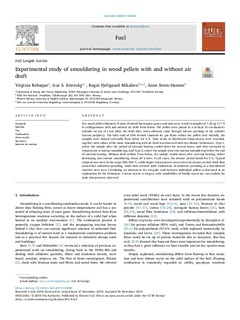| dc.contributor.author | Rebaque, Virginia | |
| dc.contributor.author | Ertesvåg, Ivar Ståle | |
| dc.contributor.author | Mikalsen, Ragni Fjellgaard | |
| dc.contributor.author | Steen-Hansen, Anne | |
| dc.date.accessioned | 2020-01-17T13:58:56Z | |
| dc.date.available | 2020-01-17T13:58:56Z | |
| dc.date.created | 2020-01-13T11:52:48Z | |
| dc.date.issued | 2020 | |
| dc.identifier.citation | Rebaque, V., Ertesvåg, I. S., Mikalsen, R. F., & Steen-Hansen, A. (2020). Experimental study of smouldering in wood pellets with and without air draft. Fuel, 264. | en_US |
| dc.identifier.issn | 0016-2361 | |
| dc.identifier.uri | http://hdl.handle.net/11250/2636869 | |
| dc.description.abstract | Dry wood pellets (diameter 8 mm) of mixed Norwegian spruce and pine were tested in samples of 1.25 kg (1.7 l) in configurations with and without air draft from below. The pellets were placed in a vertical 15 cm diameter cylinder on top of a hot plate. Air draft inlet, when allowed, came through narrow openings in the cylinder bottom periphery. The bulk void of 36% formed channels for gas flows within the pellets bed. Initially, the samples were heated externally from below for 6 h. Time series of distributed temperatures were recorded, together with values of the mass. Smouldering with air draft was observed with two distinct behaviours: Type 1, where the sample after the period of external heating cooled down for several hours, and then increased in temperature to intense smouldering, and Type 2, where the sample went into intense smouldering before the end of external heating. Without draft airflow from below, the sample cooled down after external heating, before developing into intense smouldering about 20 h later. In all cases, the intense period lasted for 2 h. Typical temperatures were in the range 300–450 °C, while higher temperatures occurred in the intense period. Draft flow caused fast oxidation spreading, while slow without draft. Indications of oxidation spreading as a distriäbuted reaction were seen. Circulating air motions in the irregular void between individual pellets is discussed as an explanation for the behaviour. Uneven access to oxygen, with possibilities of locally excess air, can explain the peak temperatures observed. | en_US |
| dc.language.iso | eng | en_US |
| dc.publisher | Elsevier | en_US |
| dc.rights | Navngivelse 4.0 Internasjonal | * |
| dc.rights.uri | http://creativecommons.org/licenses/by/4.0/deed.no | * |
| dc.subject | smolder | en_US |
| dc.subject | fire | en_US |
| dc.subject | combustion | en_US |
| dc.subject | poros media | en_US |
| dc.subject | buoyancy | en_US |
| dc.subject | internal air motion | en_US |
| dc.title | Experimental study of smouldering in wood pellets with and without air draft | en_US |
| dc.type | Journal article | en_US |
| dc.type | Peer reviewed | en_US |
| dc.description.version | publishedVersion | en_US |
| dc.rights.holder | © 2019 The Author(s). | en_US |
| dc.source.pagenumber | 15 | en_US |
| dc.source.volume | 264 | en_US |
| dc.source.journal | Fuel | en_US |
| dc.identifier.doi | 10.1016/j.fuel.2019.116806 | |
| dc.identifier.cristin | 1771285 | |
| dc.relation.project | Norges forskningsråd: 238329 | en_US |
| cristin.unitcode | 203,0,0,0 | |
| cristin.unitname | Høgskulen på Vestlandet | |
| cristin.ispublished | true | |
| cristin.fulltext | original | |
| cristin.qualitycode | 2 | |

